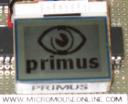Primus in control and moving
After a lot of messing about with other stuff, Primus is now back on track and has the basic motion code written and installed. Movement within the maze is possible with steering off the walls to prevent collisions; fixed size moves and in-place turns are functioning; forward error detection and correction is working.
